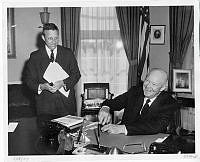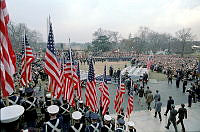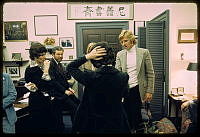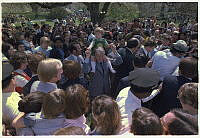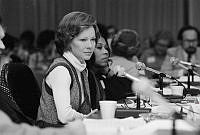Rubenstein Center Scholarship
Texas and the White House
Gallery
-

First Lady Johnson and Nash Castro, Assistant Director of the National Capital Region for the National Park Service and Liaison to the White House, review their beautification work near the Potomac River.
Lyndon B. Johnson Presidential Library and Museum/NARA -

The Johnson China Service was frequently used by successive presidents until the Ronald Reagan administration.
White House Historical Association -

President George H.W. Bush's Oval Office décor in April 1991.
White House Historical Association -

Former first ladies sit with First Lady Barbara Bush at the dedication ceremony for the Ronald Reagan Presidential Library and Museum on November 4, 1991. From left to right: Lady Bird Johnson, Pat Nixon, Nancy Reagan, First Lady Barbara Bush, Rosalynn Carter, and Betty Ford.
George Bush Presidential Library and Museum/NARA -

President George W. Bush's Oval Office décor. His favorite painting, "A Charge to Keep" by W.H.D. Koerner, hangs on the right.
White House Historical Association -

President George W. Bush presides over a ribbon-cutting ceremony for the renovated James S. Brady Press Room on July 11, 2007.
George W. Bush Presidential Library and Museum/NARA -

The White House Library after refurbishment during the Bush administration.
White House Historical Association -

The Family Movie Theater after refurbishment during the Bush administration.
White House Historical Association -

The Lincoln Sitting Room after the completion of Mrs. Bush's renovation and restoration project.
White House Historical Association -

The Lincoln Bedroom in 2005 after Mrs. Bush's renovation and restoration project.
White House Historical Association
While there have only been a handful of Texans who have called the White House “home,” this group has shaped the building’s history in many significant ways. The first Texas-born president, Dwight D. Eisenhower, lived briefly in Denison before his family moved to Abilene, Kansas. Eisenhower spent most of his childhood in Abilene and considered it his hometown; today it houses his presidential library and museum. George H.W. Bush and George W. Bush were born in Massachusetts and Connecticut, but they both considered Texas their native state. After leaving office both decided to build their presidential libraries in-state at College Station and Dallas. Claudia “Lady Bird” Johnson, born near Karnack, Texas, shares the title of Texas first lady with Laura Bush, a native of Midland. But Lady Bird’s husband, Lyndon Baines Johnson, appears about as Texan as one could possibly imagine. Born near Stonewall, Johnson spent most of his adult life serving the people of Texas in the United States House of Representatives and Senate. After Lyndon’s unexpected ascent to the presidency after the death of John F. Kennedy, the Johnsons would make a lasting impact by embracing Jacqueline Kennedy’s vision of the White House as a “living museum.” Nearly forty years later, Laura Bush would build upon that tradition, carrying out Texas-sized refurbishing projects during her time in the Executive Mansion.
Beginning in 1961, First Lady Jacqueline Kennedy embarked on a major White House restoration project, one that ultimately created the White House Historical Association to assist the Executive Mansion with historic acquisitions and preservation efforts. During their time in the White House, the Kennedys hired three professional curators—Lorraine Waxman Pierce, William Vos Elder, and James R. Ketchum—to maintain the expanding collection. However, this progress appeared to be in jeopardy as Jacqueline Kennedy silently vacated the White House in December 1963. While she was most interested in beautification, Lady Bird Johnson understood the importance of Kennedy’s preservation work, so much so that she began poring over letters, files, committee meeting minutes, and memos to familiarize herself with Jacqueline’s mission. She even visited Mrs. Kennedy at her Georgetown residence on February 28, 1964, where they discussed creating a more permanent means of preserving White House history. Lady Bird asked the former first lady if she would be willing to serve on an advisory committee specifically tasked with the preservation of the White House. “There must be somebody who provides the flame, who furnishes the inspiration, and I think she is the natural person for this,” wrote Lady Bird in her diary.1 Kennedy agreed, and Mrs. Johnson returned to the Executive Mansion in high spirits.
About a week later, President Johnson issued Executive Order 11145, which outlined the responsibilities of the new position of White House Curator: “The Curator shall assist in the preservation and protection of the articles of furniture, fixtures, and decorative objects used or displayed in the principal corridor on the ground floor and the principal public rooms on the first floor of the White House, and in such other areas in the White House as the President may designate.”2 The law also created the Committee for the Preservation of the White House. This group of government officials, decorative arts experts, and presidential appointees advises the president on “the preservation and the interpretation of the museum character” of the White House. The thirteen-member committee—consisting of the National Park Service’s director, the White House Curator, the Smithsonian Institution’s secretary, the chairman of the Commission of Fine Arts, director of the National Gallery of Art, the Chief Usher, and seven private members appointed by the president—has offered its professional recommendations and expertise to successive administrations ever since. While Jacqueline Kennedy had provided the vision, the Johnsons delivered the means.3

President George W. Bush speaks with his father, former President George H.W. Bush, in the Oval Office on May 2, 2001.
George W. Bush Presidential Library and Museum/NARAThe Curator and the Committee took on more pressing matters, especially pertaining to the Executive Mansion’s interiors and collection of artifacts. Naturally, Mrs. Johnson turned more of her attention to the outdoors, one of her lifelong passions. She brought back landscapist Rachel Mellon, who had designed the Rose Garden for the Kennedys, to revive the East Garden on the other side of the house. On April 22, 1965, President and Lady Bird Johnson christened the space, “The Jacqueline Kennedy Garden.” Surrounded by blooming hyacinths, violets, Virginia bluebells, tulips, and jonquils, Lady Bird proudly remarked, “This garden, every detail of it, reflects the unfailing taste of the gifted and gracious Jacqueline Kennedy.”4 A number of Kennedy and Bouvier family members attended the ceremony, however Mrs. Kennedy declined the invitation, reluctant to return to a place where she, according to one account, “had known so much tragedy.”5
Lady Bird also accomplished another garden initiative toward the end of her husband’s presidency. The Children’s Garden, designed by Edward Durrell Stone Jr. and Edward Alexander, is located on the west side of the South Grounds. The 18 by 30 feet garden features the bronze molds of footprints and handprints of presidential grandchildren, embedded in blue Pennsylvania flagstones. The Johnsons, who became grandparents during their time in the White House, created the space for children so they could “escape from the hustle and bustle of the executive mansion.”6 It was dedicated on January 19, 1969—the president’s last full day in office.
Lady Bird’s affection for landscapes and wildflowers was not limited to the White House Grounds. In fact, she created her own advisory board—The Committee for a More Beautiful Capital—to assist her in beautifying Washington, D.C. She worked closely with Nash Castro, Liaison to the White House for the National Park Service and a founding member of the White House Historical Association, to clean up city parks, plant thousands of trees and flowers, and revamp neglected green spaces.

This portrait of First Lady Claudia Alta "Lady Bird" Johnson was painted by Elizabeth Shoumatoff in 1968.
White House Historical Association (White House Collection)But perhaps the finest example of Lady Bird’s love for nature can be found in the elegant china service ordered for the Johnson White House. Designed by Tiffany & Company and produced by Castleton China, the dinner service featured Lady Bird’s wildflower favorites—bluebonnets, Indian blanket, and coreopsis—around the apricot-and-gold rim. The dessert service was hand-painted with the official flowers of all fifty states and the District of Columbia. The 2,208 piece set was the largest ever ordered for the White House, and would serve the administrations of Richard Nixon, Gerald R. Ford, and Jimmy Carter, as well as thousands of their guests.7
Twenty years passed before another Texan president roamed the halls of the White House. While they only spent four years in the Executive Mansion, George H.W. Bush and Barbara Bush left their mark in several important ways. President Bush redecorated the Oval Office with American-made furnishings, strictly adhering to an 1826 law that mandated “all furniture purchased for use of the President’s House shall be as far as practicable of American or domestic manufacture.”8 He had the desk from his Vice President’s office brought into the Oval, and outfitted the room with steel blue damask drapes, a blue, gold, and ivory rug, and two cream-colored sofas. He also refurbished the Treaty Room on the Second Floor of the Residence, turning the space into his personal office. The president chose a pale green color for its walls and placed the famous Resolute Desk in the office.9
After exploring the building, along with its countless historic antiques and artifacts, First Lady Barbara Bush concluded that the White House needed more funds to continue acquiring and preserving the collections. In January 1990, she announced a campaign to raise 25 million dollars in donations to provide permanent funding for the White House collection.10 She wrote all former first ladies, asking them to serve on an advisory committee for the White House Endowment Fund later that spring. The fund eventually became part of the White House Historical Association, which continues to oversee private fundraising for White House acquisitions, restorations, and conservation projects.11 While the first lady supervised a number of refurbishing projects—repainting the Vermeil Room, marbleizing the mantles in the East Room, installing new carpets and rugs throughout the house, and replacing draperies in the Blue Room—her biggest contribution came in her revival of the Committee for the Preservation of the White House and creation of the White House Endowment.12

This picture, taken by Abbie Rowe of the National Park Service on July 17, 1964, shows Mrs. Johnson presenting the one millionth copy of "The White House: An Historic Guide" to Mrs. C.J. Vessel of Omaha, Nebraska. The guidebook was first published in 1962.
National Archives and Records AdministrationEight years later, the next generation of the Bush family arrived at 1600 Pennsylvania Avenue. President George W. Bush and First Lady Laura Bush proudly displayed their Texas roots at the White House. The president selected several paintings of Texas scenes—such as the iconic Alamo, desert landscapes, and fields of bluebonnets—for the Oval Office. These works were produced by Texas artists and given to the White House on loan by museums in San Antonio, Dallas, and El Paso.13 His favorite painting, “A Charge to Keep” by W.H.D. Koerner, was lent to the president by Joe O’Neil, a friend from Midland, Texas. O’Neil had introduced George to Laura at his family barbeque back in 1977. When asked about the meaning of the portrait, the president responded, “It’s obviously a religious painting. And I tell people the President should never promote a religion. But the President always ought to jealously guard and defend the right for anybody to worship or not worship, that we’re all equal...the greatness about America is you can choose and worship the way you want to worship.”14
President Bush also ordered a major renovation of the James S. Brady Press Room in the West Wing. The space reopened on July 11, 2007 with a ribbon-cutting ceremony, followed by a brief exchange with reporters. The president welcomed the White House correspondents back, joking “We missed you—sort of.” He went on to describe the relationship between the president and the press, and how they might not like his decisions and he might not like how they write about his decisions. “Nevertheless, it’s a really important part of our process. And the fact that you were working in substandard conditions just wasn’t right,” remarked the president.15
First Lady Laura Bush accomplished several refurbishing and restoration projects in the Executive Mansion. On the Ground Floor, she took a personal interest in the Library. As a former teacher and librarian, Mrs. Bush studied the first White House library created by Abigail Fillmore in the 1850s, as well as President Franklin Roosevelt’s decision to designate a specific room for a White House library in 1935.16 She selected a number of significant literary works to strengthen the collection and altered the room’s interior as well, choosing a darker, crimson color for the inner shelves, upholstery, and window curtains. Her enthusiasm for promoting authors and works of American literature continued well beyond the walls of the White House Library, as Mrs. Bush modeled the inaugural National Book Festival in 2001 on the successful Texas Book Festival.

The Jacqueline Kennedy Garden, located on the southeast side of the White House, was dedicated on April 22, 1965 by President Johnson and First Lady Lady Bird Johnson.
White House Historical AssociationIn the East Colonnade, the Family Theater was completely remodeled at the First Lady’s direction. The walls, plush chairs, and stadium-style seats were wrapped in bright red fabrics, and the room’s dark wood paneling and gold patterns evoke reminisces of Hollywood’s Golden Age. On the State Floor the silk fabric wallpaper of the Green Room, originally selected by Jacqueline Kennedy and replaced several times since, was due for another treatment. But Mrs. Bush’s biggest project took place on the Second Floor of the Residence.
The Lincoln Bedroom and adjacent Lincoln Sitting Room were completely transformed during the Bush administration. The bedroom, which was actually used as Lincoln’s office and Cabinet Room, has attracted much attention from presidents, first ladies, and curious guests over the years. President Harry Truman designated its present location after his renovation of the White House in 1948-1952, and Lincoln-era furnishings have accumulated in the room ever since. Little was done in terms of refurbishing because the Lincoln Bedroom, technically a private room, fell outside the purview of the Committee for the Preservation of the White House. It also failed to qualify for funds from the White House Endowment because it was not on the State Floor or considered a public room. However, the White House Historical Association financed the extensive project through their partnership.17
First Lady Laura Bush envisioned returning the bedroom and sitting room to the Lincoln-era in several ways. First, the green carpeting and yellow wall coverings would reflect those used in Lincoln’s office during his presidency. Second, First Lady Mary Todd Lincoln had purchased furniture, draperies, and bed hangings for the Prince of Wales Room down the hall; this included the famous rosewood bed nicknamed after Lincoln, who never actually slept in it. The bed remained the focal point of the Lincoln Bedroom, though it was missing its Lincoln-era gilded bed cornice. This piece was accidentally destroyed in 1928 and had to be reproduced based on descriptions from the time and later photographs. Purple hangings and lace curtains were added, and the cornice served as the inspiration for the ones hanging over the windows. A yellow silk brocatelle, trimmed with purple and gold bullion fringe, framed the windows and complemented the bed cornice’s purple and gold motif. Finally, many of the Lincoln-era furnishings were returned to the room. Four Gothic Revival walnut chairs, the only ones remaining from Lincoln’s cabinet, are divided between the Lincoln Bedroom and Lincoln Sitting Room. Lincoln’s desk, acquired in 1930 from the Soldiers’ Home in Washington, D.C. and where many believe the president drafted the Emancipation Proclamation during the summer of 1862, sits in the southwest corner. Completed in November 2005, the renovation of the Lincoln Bedroom and Lincoln Sitting Room was a profound success for the White House, one that will benefit future first families and their guests for generations to come.18

This photograph shows the Children's Garden, inspired by Lady Bird Johnson and dedicated on January 19, 1969.
White House Historical AssociationWhile there have only been a handful of Texans to live at 1600 Pennsylvania Avenue, they have made a remarkable impact on the White House and its preservation. The White House Historical Association often rightfully acknowledges founder Jacqueline Kennedy, but Lady Bird Johnson, Barbara Bush, and Laura Bush also deserve recognition for advancing WHHA’s mission and their efforts to preserve White House history. The Johnsons took Mrs. Kennedy’s vision and formally authorized it through law, creating the Office of the Curator and the Committee for the Preservation of the White House. Barbara Bush recognized that Congressional funds were not enough for basic household expenses, let alone adding to and maintaining the White House collection. Her interest sparked a revival of the Committee and the creation of the White House Endowment, which continues to finance acquisitions, restorations, and refurbishing. Laura Bush’s extensive work—in the Library, Family Theater, Green Room, Lincoln Bedroom and Lincoln Sitting Room—can be attributed to her lifelong passion for learning and appreciation for American history. All of these women, along with their Texan husbands, labored to make the White House feel a little more like home while preserving its history for future residents and visitors.














